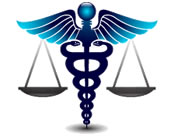

Medical Malpractice Connections

-
Surgical Negligence
- Adrenalectomy (Removal of Adrenal Gland)
- Adjustable Gastric Banding
- Appendectomy (removal of the appendix)
- Cholecystectomy (removal of gallbladder)
- Colectomy (colon resection)
- Common bile duct exploration
- Diagnostic Laparoscopy
- Enterectomy (small bowel resection)
- Enterolysis (removal of scar tissue in the abdomen)
- Esophagectomy (removal of esophagus)
- Fundoplication (surgery for heart burn)
- Gastrectomy (removal of the stomach)
- Gastric bypass
- Gastric Sleeve
- Hepatectomy (resection of portion of the liver)
- Hernia repair
- Hiatal Hernia Repair
- Pancreatectomy (removal of portion of the pancreas)
Common Bile Duct Exploration
The Condition
The bile duct connects the liver with the intestine. Sometimes this duct can become blocked with a gallstone. This can produce jaundice (yellow skin) and possibly severe infection. A common bile duct exploration is performed to remove these stones.
Symptoms
- Jaundice (yellow skin)
- Itching all over
- Very dark (tea-colored) urine
- Very light (clay-colored) stools
- Abdominal pain
- In severe cases: fever, pain, jaundice, and confusion
Common Bile Duct Exploration
Often times the common bile duct exploration is done at the same time of a cholecystectomy (gallbladder removal). This operation can be done open or laparoscopically. For the open approach a large incision will be made on the abdomen. For the laparoscopic approach the surgeon will make about 3-4 small incisions on the abdomen. A port (nozzle) is inserted into one of the slits, and carbon dioxide gas inflates the abdomen. This process allows the surgeon to see inside of the abdomen more easily. A laparoscope is inserted through another port. The laparoscope looks like a telescope with a light and camera on the end so the surgeon can see inside the abdomen. Surgical instruments are placed in the other small openings and used to explore the common bile duct and remove any stones. This is done by making a small cut on the duct, and then inserting a flexible scope and flexible instruments inside the duct. Stones are removed with metal or plastic snares. After the duct has been explored and cleaned, the carbon dioxide is released out of the abdomen through the slits, and then these sites are closed with sutures or staples, or covered with glue-like bandage and steri-strips. A temporary rubber drain (pencil-thin tube) may be left in the common bile duct, with the end of this drain exiting from the skin.
Nonsurgical Treatment
Sometimes stones in the common bile duct are removed by placing a scope down the throat and into the intestine. This is known as an ERCP; alteratively a catheter can be inserted into the side to gain access into the bile duct. This is known as a PTC. The doctor should discuss with the patient the best approach to treat the problem.
Risks
The primary risks of common bile duct exploration are:
- Infection of the skin at one of the small ports sites
- Collection of pus inside the abdomen (intra-abdominal abscess)
- Injury of the common bile duct
- Postoperative ileus (the intestines slow down/stop working for several days)
- Leakage of bile
Medical Negligence
The above mentioned risks and complications are known to happen with common bile duct exploration and such complications do not necessarily constitute deviation from the medical standard of care. The following examples however may be considered as medical negligence.
- Common Bile Duct Injury may result in morbidity and mortality.
- Delay in diagnosis and treatment of bile leak.
| Top of page |
| Home | Medical Malpractice Attorneys | Medical Experts | Medical Negligence | Services | Statute of Limitations | About Us | Contact Us |